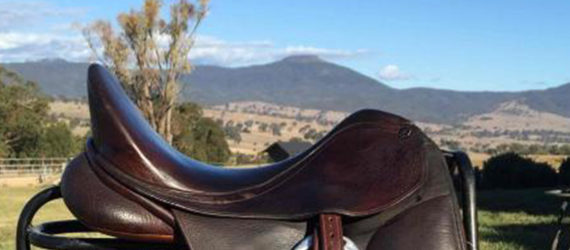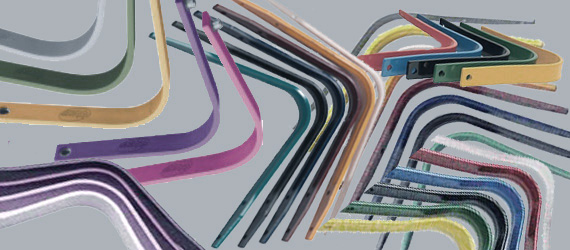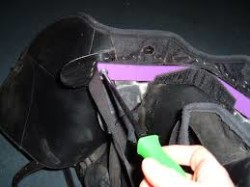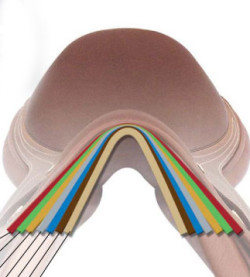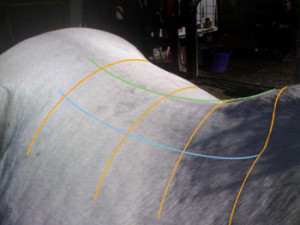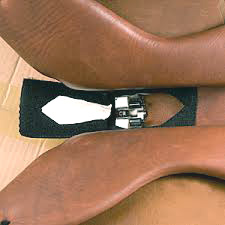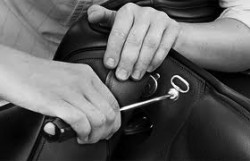How curious are you as a horse owner? Do you want to know how things work, what they look on the inside, and if they’re as good as the makers say – right the way through?
The guts of any piece of equipment are usually less pretty than the exterior, but nevertheless, we’re often happy to take the manufacturer’s word on trust.
Yet when the marketing message is that a particular brand is actually healthier for the horse’s back on account of its inbuilt ‘systems’, it’s definitely time to take a closer look. Consider a message such as this:
“Naturally, horses will demonstrate a marked improvement in performance when changed to a saddle featuring CAIR®.”
http://www.easychangefitsolution.com/saddle_brands/wintec-saddles.html (13/3/2017)
That’s pretty grand, isn’t it? How wonderful if it were only true. But working in Australia, birthplace of Weatherbeeta, Bates and Wintec, and a chain of saddlery stores that sells and fits these saddles, which is owned by that same company, I do find much evidence that persuades me otherwise.
At this point, I must make my usual disclaimer: I have no problem with any saddle that genuinely fits the horse. I do have a problem with misleading claims, intentional or otherwise, as expressed in my earlier article, Debunked: The Lie That’s Told About Adjustable Saddles.
© All text copyright of the author, Jane Clothier, https://thehorsesback.com.
CAIR for the horse – or EASY-Marketing?
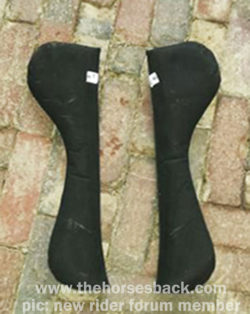
Google CAIR and you’ll find it described as the “revolutionary CAIR® Cushion System for the ultimate performance panel”.
Navigating a range of websites, you might also discover that it is accompanied in saddles by the EASY-CHANGE® Gullet System and the EASY-CHANGE® Riser system.
Together, these three comprise the EASY-CHANGE® Fit Solution.
Confused yet? No matter, as you can read all about it on the EASY-CHANGE® website…
Crazy as I find the labelling, and let’s be honest, the brand marketing department has gone a bit nuts, what really bothers me is that these much vaunted systems are not doing what it says on the packet. Nowhere near.
The problem with systems…
In my view, systems often evolve to the benefit of the people who operate them. That is fine: they make problems easier to understand and easier to navigate – and saddle fitting is certainly a problem when you can’t find the right fit for your horse.
So if a system results in a better saddle fit and, as the website suggests “your horse’s absolute comfort and your peace of mind”, all well and good.
But where systems go wrong is when the function of making life easier for people is given more importance than the problem they were originally intended to resolve.
Or, indeed, when they become an effective way of achieving increased sales through the handy marketing push they make possible.
And this bugs me because the horse’s much vaunted comfort is usually by this stage sliding further and further down the importance pile. Like a growing number of equine professionals, I’ve taken a look inside these saddles, and something simply isn’t adding up between the message and the reality.
At this point, I will say no more, but instead present some of the website content I’ve been reading this month. Alongside it, you’ll find some photos that I and others have taken.
Beyond the photo captions, I’ve made no comment until the last section on flocking. I found that had no choice, because the ‘secret flock sock’ is so secret, I can find no website content about it… Let’s just say that seems a little unusual.
“The CAIR® Cushion System”
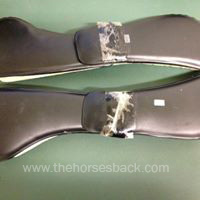
“Fluidly working with your horse’s muscles, the revolutionary CAIR® Cushion System replaces traditional fillings in your saddle with air. The cushioning nature of air encourages your horse to soften, relax and engage. Seated closer to your horse, you become simply an extension of one another. Transcend into a new world of opportunities through the power of true connection. Empower your horse with the ultimate in comfort, and explore your true potential together with the CAIR® Cushion System. ”
http://caircushionsystem.com/noflash.htm (13/3/2017)
“CAIR: The Power of True Connection”
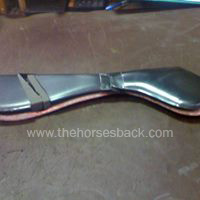
“Finally a panel system that understands the mechanics of the equine back and the impact saddles have on horse and rider performance. The revolutionary CAIR® Cushion System replaces the traditional fillings in your saddle panel with air. There are two independently sealed Air Cushions within each Saddle Panel. The concept of air, as the ultimate in cushioning for the horse is simple.”
http://caircushionsystem.com/whatIsCAIR/index.htm (13/3/2017)
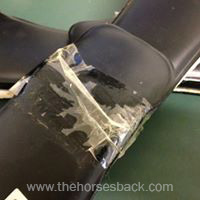
“Air being a fluid medium will constantly adapt to the horse’s working muscles. This means that your weight will be distributed evenly across the entire length of the cushion, virtually eliminating pressure points. This extraordinary comfort results in freer movement, better carriage and a happier horse. For such a simple concept the dramatic difference the CAIR® Cushion System makes to a horse’s comfort and performance is profound.”
http://caircushionsystem.com/whatIsCAIR/index.htm (13/3/2017)
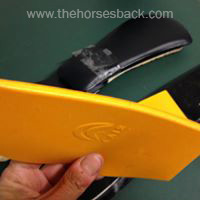
“The award winning CAIR® Panel Insert System was launched to retailers and saddle fitters around the world. Together with the tree adjustability of the EASY-CHANGE® Gullet System, this delivered a whole new level of adjustability in saddles. The insert system enabled retailers and saddle fitters to make adjustments within the panel effectively, efficiently and to the highest professional standards.”
http://www.easychangefitsolution.com/easy-change-story.html (13/3/2017)
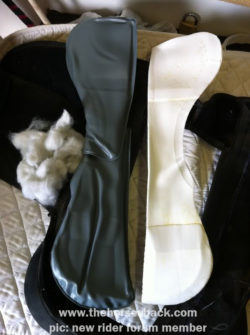
“The challenge lies in developing an air system that limits any opportunity for human interference on the performance of the panels.
“The cutting edge Research and Development Team at Bates Australia have spent many years refining and perfecting techniques for incorporating an air cushion into a saddle panel, before reaching a breakthrough in manufacturing method.
The CAIR® Air Cushions are shaped and refined at the point of manufacture to provide an even thickness throughout the panel….”
http://caircushionsystem.com/
whatIsCAIR/evolution.htm (13/3/2017)
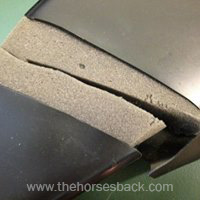
“What is Inside an Air Panel?”
“Air is captured at atmospheric pressure in an open-celled foam and sealed in the Air Panel. Once the air panel is welded the open-celled foam becomes irrelevant, as it is the air trapped in the panel, which is doing the work.
Furthermore, the balance of saddles with the CAIR® Cushion System is easily altered without compromise to the performance of the air panels.”
http://www.caircushionsystem.com/faqs/index.htm (13/3/2017)
** Questions, thoughts or comments?
Join us at The Horse’s Back Facebook Group.
“How adaptable are the saddles for achieving an optimal fit?”
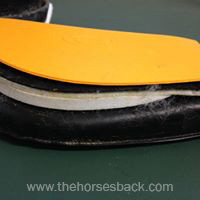
“Extremely, Saddles that feature both the CAIR® Cushion System and EASY-CHANGE Gullet System are unsurpassed in the flexibility they offer for achieving an optimal fit.
Once you have selected the correct gullet size for your horse, the CAIR® Panel Insert System enables you to alter the balance of your saddle without compromising the performance of the Air Panels.”
“Official Fit Disclaimer”
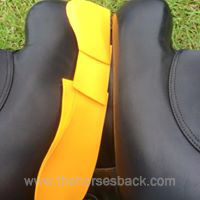
N.B whilst the innovative EASY-CHANGE® Fit Solution offers unsurpassed flexibility in achieving an optimal fit, no one saddle can claim to fit every horse. It is always recommended ongoing professional advice is sought on the fit and in meeting the unique needs of each horse/rider combination. Global patents and design registrations apply.
http://www.easychangefitsolution.com/easy-change_fit_solution/index.html (20 Sept 2015)
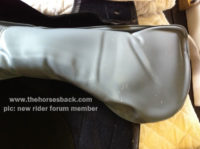
“The Current Day…”
“Bates Australia has now developed a means of offering these saddle fitting systems in both saddles featuring high performance CAIR® panels, as well as traditional flocked panels.”
http://www.easychangefitsolution.com/easy-change-story.html (13/3/2017)
But Hang On… “Traditional flocked panels”… What are they talking about?
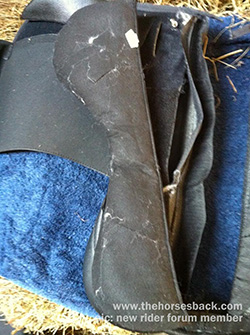
OK, this is where I break my silence. This is where I introduce the flock panel insert.
The thing is that for the past 2-3 years, other company saddlers have been finding these rather strange, stuffed fabric panels inside Wintec and Bates saddles brought in by customers requesting reflocking.
These fabric sleeves, which are the same shape as the vinyl CAIR sleeve, are packed hard and tight, meaning that the usual benefit offered by flocking – ie, ability to mould to the horse’s shape – is lost altogether. You won’t hear about that though, because this is a manufacturer’s secret (shhhh).
Where Can We Find the Flocking Info?
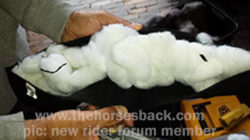
Oddly, and strangely given all the Easy web pages, this ‘flock sock’ doesn’t have its own page and isn’t photographed on any of the Wintec, Bates and EASY-whatever websites.
Why? I’d speculate that the sock removes considerable time and dollars off the manufacturing cost of flocked saddles, without adding much that’s positive at the horse end of the equation.
[ed note. I’ve removed the detail about pricing here, because I made a mistake with it. That obviously isn’t good enough. I’m sorry about that.]
So, why is nobody hearing about this little innovation? The company don’t want to add flocking to saddles as it’s less profitable, but is offering ‘flocking’ (or their own version of it) simply to satisfy customer demand. Unfortunately, with this inner working of the saddles kept out of sight, the customer simply doesn’t know what they’re paying for.
And how good is that for the horse’s interests, we must ask?
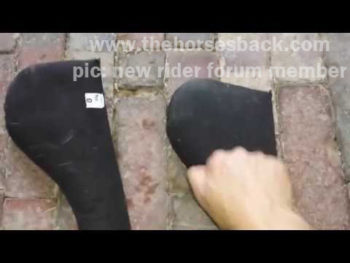
** Questions, thoughts or comments? Join us at The Horse’s Back Facebook Group.
